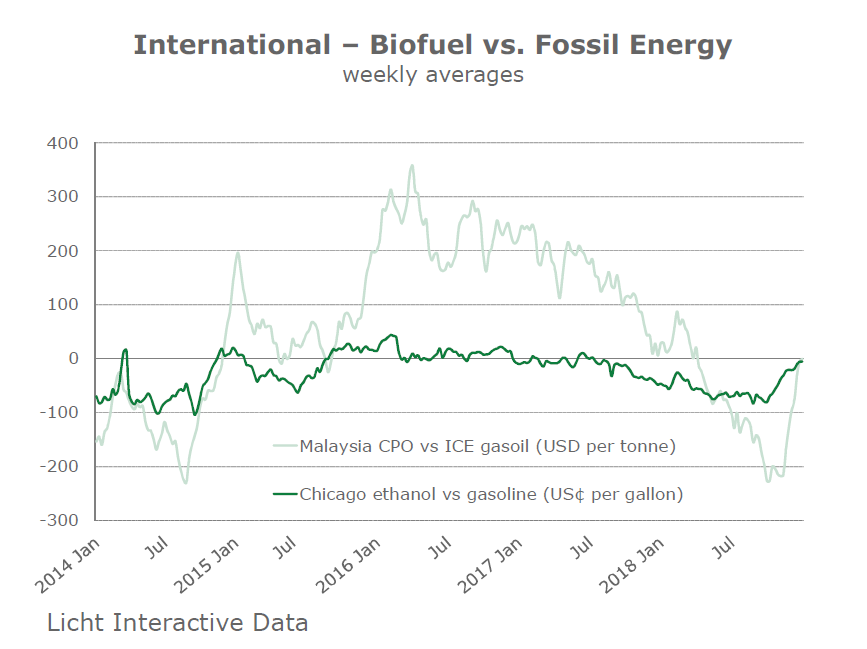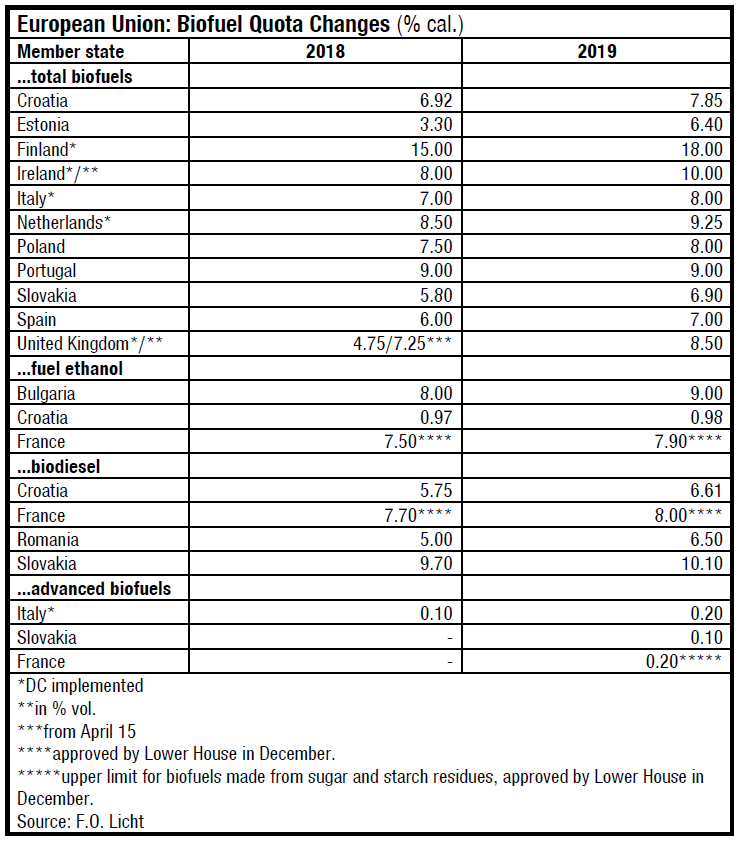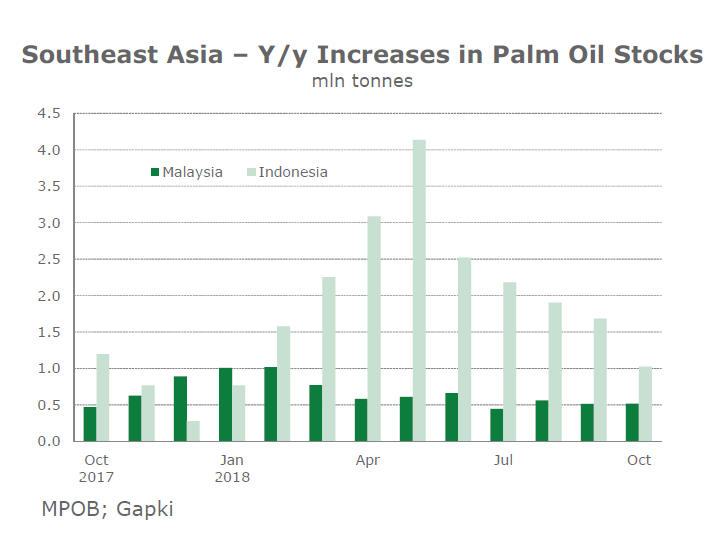From US corn ethanol through to Argentine biodiesel, this is F.O. Licht's comprehensive assessment of the pricing dynamics, regulations and crop conditions that will shape the global biofuels market over the next 12 months.
2018 saw volatility in fossil energy prices, concern over dwindling grain supplies and another surplus in palm oil, prompting strong support for biodiesel mandates in Asia.
At the same time, the Sino-US trade war heavily impacted the global commodities trade, while in the United States, discussions over the Renewable Fuels Standard (RFS) went on.
Last but not least, the European Union’s biofuel market saw strong arrivals of Argentine and Indonesian biodiesel. Will this go on in 2019?
Want more articles like this? Sign up for the KNect365 Energy newsletter>>
The global perspective
Discretionary blending is set to remain an option for biofuel producers in 2019.
True, the outlook on crude oil prices is always a very uncertain affair. Apart from the geopolitical risks in the Middle East, there are bearish factors such as the Sino-US trade tensions.
At the same time, oil exporters like OPEC and its allies can cut production. However, what we can already see is that high ethanol inventory levels in the US act as a cap on prices, and the same applies to palm oil in Southeast Asia.
This means US fuel ethanol and palm oil methyl ester will continue to offer a competitive alternative to fossil product, beyond the biofuel quotas.
Ethanol feedstocks - the grains deficit will impact crushing margins in 2019.
Adverse weather conditions over the course of 2018 severely hit grains harvest results in Europe (including Russia and Ukraine) and Australia in 2018/19. It is expected that the current season will close with a deficit, which would be the first in several years.
Of course, the cereal crops in Latin America and elsewhere still have to be brought in, but the market has already priced in strong corn harvest results in Argentina and Brazil, including high exports.
At the same time, there is concern over dry weather during planting in parts of Europe. This points to a vulnerable grains market at least for the early months of 2019. Corn plantings for 2019/20 in the Americas will also depend on export economics for soybeans to China (see below).
Biodiesel feedstocks – the outlook for plant oils is bearish, but the China/US trade tensions have the potential to boost market volatility.
Fundamentally, the 2018/19 season should end with higher stocks for palm oil and soybeans. The production outlook for palm oil in Southeast Asia is definitely bearish. Support comes from higher local demand (see below), but this will not translate into a global deficit.
At the same time, bean stocks in the US should more than double, after a record harvest, while the outlook for Argentina and Brazil is strong. Regarding the demand-side, Beijing’s tariffs on US products have of course not brought imports from that origin down to nil.
They boosted demand for beans from Brazil, but China is not able to replace the US completely with alternative suppliers due to the large volumes needed.
However, the trade war made feed use in China more expensive and likely put a lid on local consumption. This in conjunction with the risen global output cut world market prices in recent months.
An end of these tensions would reboost US bean exports, raise prices for US meals and oils (as US crushers would have fewer beans) and reduce the export outlook for beans ex LatAm (but improve that for meals and oils as more beans would become available).
It would also impact bean and corn plantings later in 2019.

Biofuel trade patterns may once again change in 2019.
A couple of trade law changes in the course of 2017 and 2018 sharply changed global trade flows.
First, the US introduced prohibitive anti-dumping and anti-subsidy (AD/AS) duty rates on Argentine and Indonesian biodiesel.
Up to August 2017, the US was the key outlet for Argentine soyoil methyl ester (SME) exporters. Following the AD and AS duties, exports ex Argentina became unfeasible, while local biodiesel suppliers and exporters elsewhere (mainly in Canada, France, Germany and Singapore) benefitted.
Argentina’s SME producers were not only saved by higher gasoil prices and sales into discretionary blending, but also by the fact that the EU had to re-open its biodiesel market after a World Trade Organisation and a local court decision against its AD duty rates on Argentine and Indonesian product imposed from 2013. Several duty cuts in 2017 and 2018 meant the EU became a key outlet for these origins again.

Will these developments continue in 2019? At the time of writing, it seems that there will be changes.
First, the US Department of Commerce is reviewing the duty rates on Argentina. More should be known in early autumn 2019.
Second, the EU biodiesel sector asked for an AS enquiry on Argentine biodiesel imports. A decision on that was scheduled for autumn 2018, but the European Commission postponed that into 2019. Recently, press reports said the Commission will propose the introduction of AS duties (see table).
Moreover, an AS enquiry on Indonesian biodiesel was initiated in early December 2018. So the threat of new duties on Argentine and Indonesian biodiesel is here to stay.
US and EU biodiesel producers point to the export tax differentials in Argentina and Indonesia, meaning lower rates for processed products like biodiesel than for feedstocks like soybeans or oil. This boosts the competitiveness of finished product from these origins.
However, Buenos Aires in recent months raised taxes in the soy complex which reduced the level of cross subsidization.
Regarding global fuel ethanol trade, the aforementioned Sino-US trade war also ended US exports and helped boost inventory levels there. Clearly, any change here would also improve the fundamental situation for US distillers.

A view on local markets and policy developments
United States 1
True, the 2019 US Renewable Fuels Standard (RFS) was fixed in late November but serious issues remain.
The US Environmental Protection Agency (EPA)’s final rule for the 2019 RFS includes a slightly higher advanced biofuels mandate but left an unchanged 15 bln gallons for conventional biofuels (mainly corn ethanol).
However, there are several issues around the US biofuels market and the RFS which have a bigger impact than the 2019 volumes. First, there is the yet-to-be-resolved issue of the RFS exemptions for small refineries.
These can apply for a waiver from the RFS on economic reasons. In recent years, the oil sector has used this tool extensively, and the EPA received much criticism for their practice to allow these waivers also for refineries run by oil majors which operate profitably.
For the US ethanol sector, this has destroyed demand, as the EPA already said that these ‘lost’ volumes will not be re-allocated to other obligated parties.
A final decision over the future of the RFS waivers has not been made at the time of writing. But both the oil sector and the corn lobby consider this as being the key battleground.
Moreover, the EPA could propose new targets for the final three years of the RFS (2020-2022), replacing the ambitious, decade-old goals set by Congress in 2007.
Congress had hoped biofuel consumption under the RFS would hit 36 bln gallons by 2022. However, there is a big shortfall in the availability of advanced biofuels, mainly in the cellulosic category. This opens another hot debate.
It should be noted that future RFS mandates are also a key determinant for Renewable Identification Number (RIN) values and current blending cost.
A large RIN bank has been accumulated in recent years. The EPA in late November said that 2.59 bln RINS or 13% of the 2019 RFS were stocked, of which 600 mln for the advanced biofuel mandate (12%).
The rationale behind these stocks are expectations on a tight RIN market due to rising RFS mandates. Any change here may devalue part of the bank and also cut blending rates.
United States 2
The BTC saga continues. In early 2018, the Blender’s Tax Credit (BTC) on biodiesel was re-introduced by Congress, but only retroactively for 2017.
That kind of legislative practice is nothing spectacular. It was not the first time that blenders expecting a comeback of the BTC bet on the right horse. So it is not only the RFS mandate which boosts biodiesel use, it also is the BTC, and this subsidy is also a key determinant for biodiesel export economics worldwide.
At the time of writing, nothing final had been decided yet, and this state could last for a long time, leaving much room for speculation about future fuel subsidies. In recent years, the US biodiesel lobby was also asking for a producer’s credit, instead of the BTC in order to compensate against high imports.
At the moment, this is not a hot topic, when considering the elevated US output and the high trade barriers. However, any change here would quickly bring the call for a producer’s subsidy back on the political agenda.

The outlook for fuel ethanol and biodiesel in Brazil is bright
The current campaign (Apr/Mar) has brought a strong rebound in fuel ethanol production, following increases in local demand, especially for hydrous grades. The growth can not only be attributed to higher fossil energy values but also to a series of policy changes, including Petrobras’ gasoline pricing policy.
At the time of writing, it seems that millers will continue to favour ethanol over sugar in 2019/20, while cane supplies should rise.
Regarding biodiesel, the local mandate rose from B-8 to B-10 from March 1, 2018, which should prompt some y/y growth in 2019.
One also has to keep in mind that the RenovaBio program, the future biofuel policy framework offering massive opportunities for fuel ethanol and biodiesel, is expected to be enacted in 2020.
The future biofuels policy of the European Union has become clearer, but palm oil will remain hotly debated.
In late autumn 2018, the European Parliament (EP) agreed on the 14.0% cal. renewable energies target in road and rail transport by 2030. For advanced biofuels the new law sets a de facto target of 7.0%.
At least half of that will need to come from advanced biofuels from waste and residues, whilst the rest is expected to come from renewable electricity and other alternative fuels, leaving room for crop-based product with low indirect land use change (ILUC) risk.
The EP vote came as no surprise as it virtually confirmed a compromise reached this June. However, the fact that the EU will differentiate between crop-based biofuels with high and low ILUC risk is politically controversial, as the former category targets palm oil, and this would mean a phase-out until 2030.
The EU fuels sector is not the key but a major consumer of Southeast Asian palm oil. More than 2.5 mln tonnes of oil are used for biodiesel production in Europe annually. Additionally, several 100,000 tonnes come in as finished product from Asia each year.
At the same time, biofuel quotas in member states rise (see table). It is likely that the bloc will get a drastic response from Indonesia and Malaysia, and that plantation companies and biodiesel suppliers in both countries will seek to prove that palm oil only has a low ILUC risk to keep their access to the EU market.

The trade issues with Europe are only one side of the medal for palm oil producers in Asia, while the other are the local biodiesel mandates.
Roughly 7 mln tonnes of palm oil may be used in Asia for biodiesel production in 2019, with demand to reach more than 8 mln, a plus of 2 mln on 2018. Indonesia has expanded its B-20 mandate over the course of 2018 and is set to consume more than 5 mln tonnes in 2019. The global palm oil surplus and improved PME vs gasoil economics allow such a massive increase.
At the same time, Malaysia’s B-10 mandate in transport will be fully implemented by February 1, 2019. Including B-7 in the industry sector from July, local use could more than double to around 0.8 mln tonnes in 2019. In Thailand, there are also efforts underway to boost local biodiesel use (B-20 in heavy transport).


